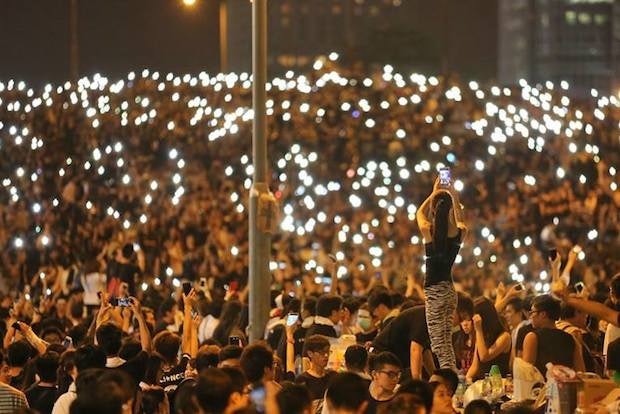
The democracy protest in Hong Kong on Monday, September 29. (Apple Daily)
As the beginning of China’s Golden Week—one of the busiest shopping times of the year—China’s National Day on October 1 is typically a date that Hong Kong’s retailers look toward with great anticipation. This year, however, they’ve been waiting for the day with a sense of dread: the massive student protests rocking city have caused fears of dismal retail sales as mainland visitors stay away.
While Chinese state-run media outlet China Daily has called retailers “the latest victim” of the Occupy Central movement running the protests, the recent events are actually only one part of the many reasons behind a decline in retail sales that has already been going on for months. Furthermore, the police’s heavy-handed crackdown on Sunday night and fear of further clashes are likely to have a bigger impact on sales than the protests themselves, which have remained peaceful.
As an estimated 50,000 to 80,000 students have flooded Hong Kong’s business district over the past week to protest the Chinese government’s decision to vet candidates for the city’s 2017 elections, road shutdowns brought many of the city’s prime shopping areas to a standstill. As emotions ran high Sunday night when police used tear gas, pepper spray, and batons against the crowd, travel agents told Reuters that the number of mainland Chinese tour bookings had dropped by 30 percent.
Since Monday, however, the situation has remained calmer as police refrained from a further crackdown. Currently, most shops in the Tsim Sha Tsui shopping area including Prada and Gucci are open, and Chanel and Burberry are “quite crowded” according to a note to investors from Exane BNP Paribas Global Luxury Goods Managing Director Luca Solca.
Nonetheless, experts are still expecting a decline in Chinese tourist numbers during this period. This will be a major drawback for retailers, who consider China’s two Golden Week travel periods to be peak sales times as mainland shoppers hit the malls to avoid tariffs. This is especially true for luxury brands, which often make 10 percent of their total worldwide sales in Hong Kong.
The demonstrations won't be completely to blame for the slump, however: Hong Kong’s mainland visitor growth rates and retail sales had already been in decline for months. Retail sales began to take a dive in February and decreased for six straight months, causing an overall 1 percent decline for the first eight months of 2014. While August saw a modest rebound with 3.4 percent year-on-year sales growth, Hong Kong’s Retail Management Association recently revised its sales growth projection for 2014 to 5 percent after previously predicting 12 percent at the beginning of the year.
This decline is the result of several factors linked to purchasing habits of mainland visitors, who made up 37 percent of Hong Kong’s retail and restaurant spending in 2013. Several of these causes have little or nothing to do with the current unrest. Although the number of mainland visitors to Hong Kong grew by 12.8 percent in the first seven months of the year, China’s ongoing anti-corruption crackdown means that they’ve been spending less on high-end luxury gift items such as watches and jewelry—luxury sales dropped 6.1 percent in Hong Kong during the month of August in the lead-up to the generally gift-heavy Mid-Autumn Festival. In addition, China’s tourism law that was enacted during Golden Week last year to crack down on tour group scams is still having an effect—last year, it caused a 44 percent decline in the number of mainland tour groups visiting the city.
Although anti-mainland prejudice is often conflated with political resistance to Beijing, Hong Kong’s protest organizers are working to distance themselves from the previous outbursts against mainland visitors, according to an Al Jazeera report.
The disruptions to traffic caused by the protests themselves will certainly have a detrimental effect on visitor numbers and retail sales, but the Hong Kong police’s use of violence on Sunday and fear of another clash with police pose much bigger problems for business. While the student protesters have cultivated a polite, “orderly” image, the risk of more tear gas (and the very small, yet terrifying chance that the PLA might intervene) is a far stronger deterrent to visitors and would certainly shutter the stores that are choosing to keep their doors open right now. "The obvious downside risk to current trading disruption would come from a violent escalation of protests and police confrontation,” wrote Solca. Peaceful demonstrations of tens and even hundreds of thousands of people have been annual Hong Kong events for years (many which had high retail growth rates), taking place on June 4, the anniversary of the 1989 Tiananmen Square crackdown, and on July 1, the day of the handover from British to Chinese rule.
As a result, the future of Hong Kong’s retail market hinges on several key factors. The length of the protests—which could be anywhere from a week to over a month—or even their size won’t be as important as how heavy-handed the government is in dealing with protesters. Furthermore, if the Hong Kong government continues to attempt to use anti-mainland sentiment for political gain to make up for public anger over electoral politics, mainlanders can simply opt to head to other easy-to-reach areas in East Asia such as South Korea, Japan, and even Hainan for duty-free shopping. While a short-term sales and tourism slump is unavoidable, the severity of its impact for retailers now hinges on the decisions of the leaders.